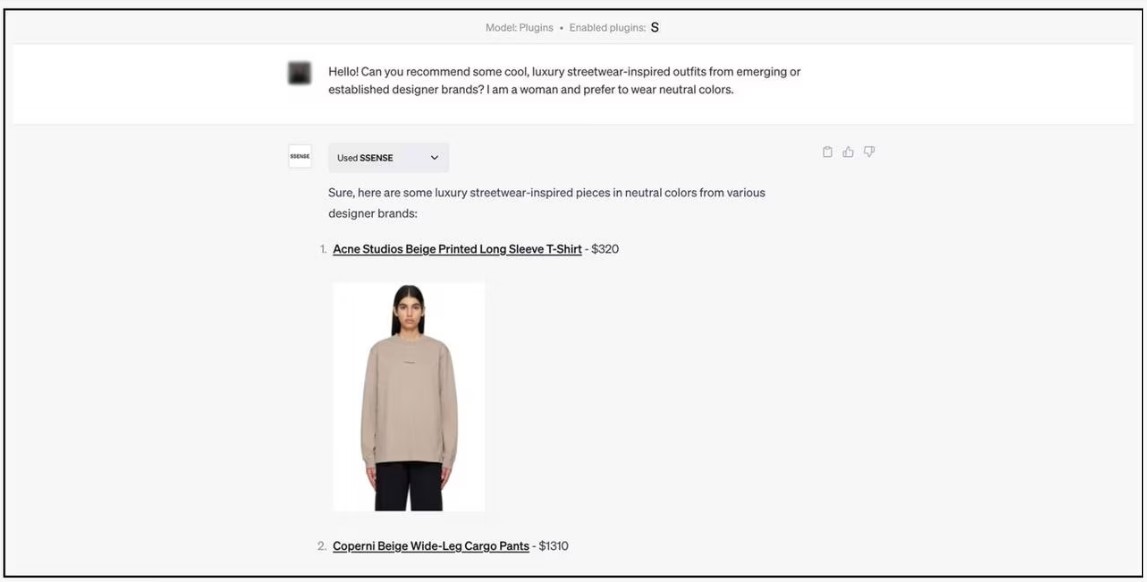Chatbot Adoption Soars as Human Assistance Fades

Unless you’ve been living under a rock, or haven’t been reading your PYMNTS newsletter, you’ve probably noticed that there’s been a massive shift in the way brands and retailers approach customer service and engagement. One key factor contributing to this shift is the adoption of generative artificial intelligence (AI) for chatbots, enabling a highly customized customer experience. But what does this mean for human jobs? Are AI and chatbots poised to replace workers, or do they provide an opportunity for humans to concentrate on strategic and creative tasks?
Ssense Looks to Chatbots
One recent development of this trend is Ssense, a fashion retailer that has recently introduced a new generative-AI chatbot to assist users with their styling and shopping inquiries.
Subscribers of ChatGPT Plus, the premium subscription of OpenAI’s text-based AI tool, are granted the exclusive opportunity to access and download a plug-in from the OpenAI store, offered by the online retailer based in Montreal.
By integrating OpenAI’s technology with their own proprietary AI models, Ssense’s chatbot aims to offer shoppers a unique experience where they can ask questions and receive responses that include direct product links from Ssense’s extensive catalogue. This integration provides users with a seamless and interactive interface, empowering them to effortlessly explore and engage with Ssense’s offerings through the chatbot.
For example, a shopper can make a specific request for “cool, luxury streetwear-inspired outfits” in neutral tones. In response, Ssense’s chatbot, looks to provide suggestions that include an Acne beige long-sleeve T-shirt and Coperni beige wide-leg cargo pants, along with a range of other adaptable products that can be easily combined and styled together.

The feature is available for ChatGPT Plus subscribers and can be downloaded from the OpenAI plug-in store, granting users effortless access to leverage the chatbot’s expertise. As a result, it enhances their shopping experience by enabling seamless use of the chatbot’s capabilities.
Earlier this year, the company embarked on an experimental journey by employing ChatGPT as a stylist on its Instagram account. The move follows several other retailers, including Shopify, Zalando, and KXNT (an online shop operated by Kering), who are exploring the potential of generative-AI chatbots to enhance the online shopping experience.
Read also: Shopify, Coca Cola Harness the Power of ChatGPT
Mercari Leverages ChatGPT
Mercari also looked to add a ChatGPT-powered shopping assistant to its marketplace platform for secondhand items.
With Merchat AI, customers can actively participate in real-time conversations with the shopping assistant, enabling them to receive personalized product recommendations that align with their specific chat prompts.
“Merchat AI marks an exciting turning point in the evolution of secondhand shopping,” Mercari U.S. CEO John Lagerling said at the time of the launch. “With this technology, we’re leveraging the transformative power of artificial intelligence to make it easier for Americans to shop and explore Mercari’s extensive marketplace.”
Read more: Mercari Adds ChatGPT-Powered Shopping Assistant to Marketplace Platform
Grocery Chatbots
Companies are also looking to personalize grocery experiences in hopes of a more custom feel.
In March, PYMNTS reported that Instacart was planning to introduce a chatbot feature that enables consumers to inquire about recipes and seek inspiration. The chatbot responses would include convenient shoppable suggestions for the users.
PYMNTS highlighted that this chatbot initiative presented an opportunity to connect with a significant portion of the online grocery shopping demographic. According to PYMNTS’ study “The ConnectedEconomy™ Monthly Report: The Gender Divide,” which surveyed over 2,600 U.S. consumers, it was revealed that 42% of men and 28% of women who purchase groceries online through same-day delivery platforms like Instacart could potentially benefit from the chatbot’s services.
Read more: Instacart to Add Chatbot as Grocers Push Boundaries on Digital Content
Chatbots in B2B
And, of course, chatbots are making their way to B2B experiences.
In April, PYMNTS reported that 75% of Walmart’s vendors preferred going about their negotiations with a chatbot. The chatbot being leveraged by Walmart has been developed by Pactum to negotiate cost and purchase terms with some of its vendors.
According to the report, the retailer employs an AI-powered tool specifically for negotiating smaller contracts with suppliers who provide equipment used by the company, rather than the goods it sells.
In a press release on January 11, Pactum revealed that its technology empowers Walmart to engage in negotiations with 2,000 suppliers simultaneously. The company further stated that, according to Walmart’s experience, 83% of suppliers find the chatbot user-friendly. Additionally, the chatbot successfully closes deals with 68% of the suppliers it interacts with, leading to an average savings of 3% for the retailer.
With that, the chatbot allows Walmart’s procurement teams to allocate their attention to larger contracts.
The retailer supplies the AI tool with its budget and requirements, and subsequently, the AI engages in negotiations with human representatives from vendors regarding discounts, payment terms, prices and other pertinent matters.
Throughout the interaction with vendors, the AI has the capability to assess the appropriate price it should pay by considering historical trends, competitor benchmarks and the cost of materials involved in producing the item.
Impact of Automation and AI
The impact of automation on the job market in the United States could potentially extend to approximately two thirds of all positions, according to a report released by Goldman Sachs.
The findings of the report indicate that around 7% of American workers are currently employed in occupations where AI has the capability to automate at least 50% of their job functions. Consequently, these individuals may face the risk of being replaced by automation.
On the other hand, approximately 63% of workers occupy roles where fewer than half of their tasks can be automated. While their jobs might remain intact, the introduction of automation could potentially free up their time, enabling them to engage in other tasks or responsibilities.
Approximately 30% of workers in the United States are employed in physically demanding or outdoor occupations that are deemed less susceptible to automation.
In an interview with PYMNTS in April 2020, Pactum CEO Martin Rand explained that automation technology in procurement provides a notable advantage through its seamless integration with enterprise resource planning (ERP) systems, which plays a crucial role in effectively applying and enforcing new agreements.
In a more recent interview with PYMNTS, Drew Smith, one of the co-founders of UPP, delved into the company’s utilization of artificial intelligence (AI) to enhance Google products, revolutionizing the online retail landscape for merchants.
One of the main points of emphasis included that Smith saw AI and UPP’s solution serve as a valuable tool that eliminates the mundane-ness from the roles of digital marketers and pay-per-click (PPC) managers. Smith emphasized that it should be perceived as an additional asset in their digital marketing and PPC management arsenal, rather than a replacement for the manager’s role.
“What it enables them to do is actually focus on strategy. How does Google align with the marketing strategy?” Smith said.
Read more: UPP Takes an AI-Powered Approach to Optimizing Google Shopping for Merchants

